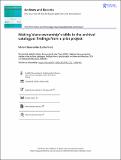Files in this item
Making "slave ownership" visible in the archival catalogue : findings from a pilot project
Item metadata
| dc.contributor.author | Buncombe, Miriam | |
| dc.contributor.author | Prest, Julia | |
| dc.date.accessioned | 2022-01-28T10:30:01Z | |
| dc.date.available | 2022-01-28T10:30:01Z | |
| dc.date.issued | 2022-01-20 | |
| dc.identifier | 276009509 | |
| dc.identifier | d23b2190-ad34-4544-817d-de1e4c9e4124 | |
| dc.identifier | 000745388500001 | |
| dc.identifier | 85123404161 | |
| dc.identifier.citation | Buncombe , M & Prest , J 2022 , ' Making "slave ownership" visible in the archival catalogue : findings from a pilot project ' , Archive and Records , vol. 42 , no. 3 , pp. 228-247 . https://doi.org/10.1080/23257962.2021.1985443 | en |
| dc.identifier.issn | 2325-7962 | |
| dc.identifier.other | ORCID: /0000-0002-3266-7390/work/107287061 | |
| dc.identifier.uri | https://hdl.handle.net/10023/24771 | |
| dc.description.abstract | This article outlines a pilot project aimed at making ‘slave ownership’ more visible in archival catalogues. The project began with the premise that it is incumbent upon academic communities and record-keepers to make known Britain’s slaving past and the ongoing legacies of that past as part of a drive to dismantle systemic (and often invisible) racism across the sector. Specifically, it explored different ways of cross-referencing the Legacies of British Slave-ownership database (https://www.ucl.ac.uk/lbs//) with the Special Collections catalogue at the University of St Andrews with a view to updating the information provided in the latter. Six methods of identifying matches were trialled, each of which is presented and reflected upon here. Although some methods produced more matches than others, the collective results point towards the need for a multifaceted approach. Our findings also raise important questions about types of involvement in enslavement (direct/indirect), how different levels of certainty regarding the identity of certain individuals might be indicated in the record, and how collection-level and item-level descriptions might be updated. The project also highlights how our own assumptions about who is — and is not — likely to have ‘owned’ enslaved people can influence our very methods for uncovering those people. | |
| dc.format.extent | 20 | |
| dc.format.extent | 808741 | |
| dc.language.iso | eng | |
| dc.relation.ispartof | Archive and Records | en |
| dc.subject | Slavery Compensation Act | en |
| dc.subject | 'Slave ownership' | en |
| dc.subject | Enslavers | en |
| dc.subject | Descriptive practice | en |
| dc.subject | Cataloguing | en |
| dc.subject | Legacies of British Slave-ownership database | en |
| dc.subject | DA Great Britain | en |
| dc.subject | T-NDAS | en |
| dc.subject.lcc | DA | en |
| dc.title | Making "slave ownership" visible in the archival catalogue : findings from a pilot project | en |
| dc.type | Journal article | en |
| dc.contributor.institution | University of St Andrews. French | en |
| dc.identifier.doi | https://doi.org/10.1080/23257962.2021.1985443 | |
| dc.description.status | Peer reviewed | en |
This item appears in the following Collection(s)
Items in the St Andrews Research Repository are protected by copyright, with all rights reserved, unless otherwise indicated.

